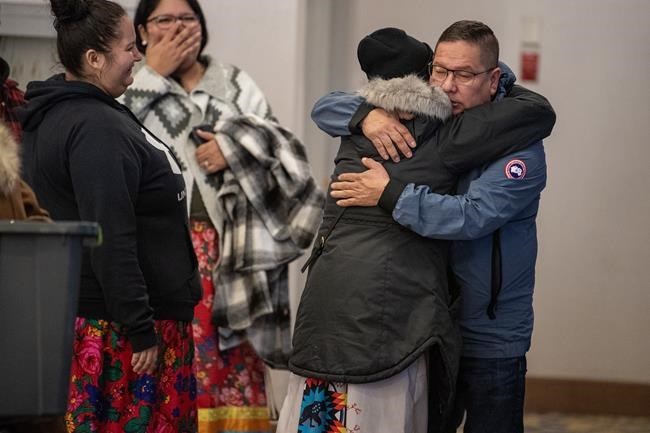SASKATOON — Community members hugged the mother of a mass killer after jurors at a Saskatchewan coroner's inquest determined he died from an accidental overdose following a high-speed police pursuit.
Myles Sanderson's family was devastated after he went on a stabbing rampage on the James Smith Cree Nation and in the nearby village of Weldon, said the killer's uncle Eddie Head.
Eleven people were killed and 17 others injured as Sanderson went door to door attacking people.
Head said his sister and Sanderson's mother, Beverly Burns, isolated herself and struggled to cope with the destruction caused by her 32-year-old son. But the inquest has brought answers, a sense of relief and a reconnection with people on the First Nation, he said.
“Our community hugged and said to each other we love each other," Head said Thursday after the inquest closed.
The four-day inquest in Saskatoon heard gripping details about how police captured Sanderson on Sept. 7, 2022, three days after the massacre.
Jurors issued four recommendations for police to improve arrests.
They said the RCMP should have mandatory enhanced driver training, and there should be more training for extraction techniques during takedowns.
Jurors also said Mounties should review their criteria for high-speed chases, and Saskatoon police should establish a dedicated team to arrest people with outstanding warrants. Sanderson was unlawfully at large at the time of the killings, and had gone to the First Nation to sell cocaine.
Assistant Commissioner Rhonda Blackmore, the commanding officer for Saskatchewan's RCMP, said Mounties will review the recommendations.
Blackmore said the inquest helped better the force's relationship with the First Nation.
"One of the most fulfilling pieces for myself personally has been the interactions with James Smith," Blackmore said.
Earlier Thursday, a criminal investigative psychologist testified Sanderson didn't intend to die while being taken into custody.
Matt Logan said Sanderson was still on a mission after the killings. His goal was to harm the mother of his children, Vanessa Burns.
"He didn't really care one way or another if he lived or died," said Logan, who is also a former RCMP officer.
The inquest heard Logan reviewed Sanderson’s court records, visited the First Nation and spoke with family members. But he didn't meet Sanderson, and nobody can be certain what the killer was thinking before he died.
Logan said after Sanderson had been on the run for three days, he pumped himself up with cocaine and went to track down his partner.
He broke into a house and stole a truck. After the homeowner called police, Mounties quickly descended on the area.
Jurors saw video from RCMP dashboard cameras of a high-speed police pursuit with Sanderson driving the wrong direction on Highway 11, a main route for vehicles travelling from the north to Saskatoon.
The chase ended after a Mountie used her vehicle to ram the truck Sanderson was driving. The killer lost control and went into a ditch.
After Sanderson was pulled from the vehicle, he asked how many people he had killed and why officers didn’t shoot him.
Sanderson then began to have seizures and was taken to hospital, where he died. A forensic pathologist testified Sanderson overdosed on cocaine.
Jurors determined the overdose was accidental.
Chief Wally Burns of the James Smith band, one of three that make up the First Nation, said healing has begun for some in the community now that they have answers. His nephew was among those killed.
Burns said he is still pushing for a national inquiry to fully understand how the rampage happened.
For now, he said, it will be important for the community to lean on their ceremonies and cultures.
A separate inquest was held last month that looked at each of the killings. It issued more than two dozen recommendations, including for the RCMP to fully staff specialized teams and to improve the relationship and communication with the First Nation.
This report by The Canadian Press was first published Feb. 29, 2024.
Kelly Geraldine Malone, The Canadian Press

